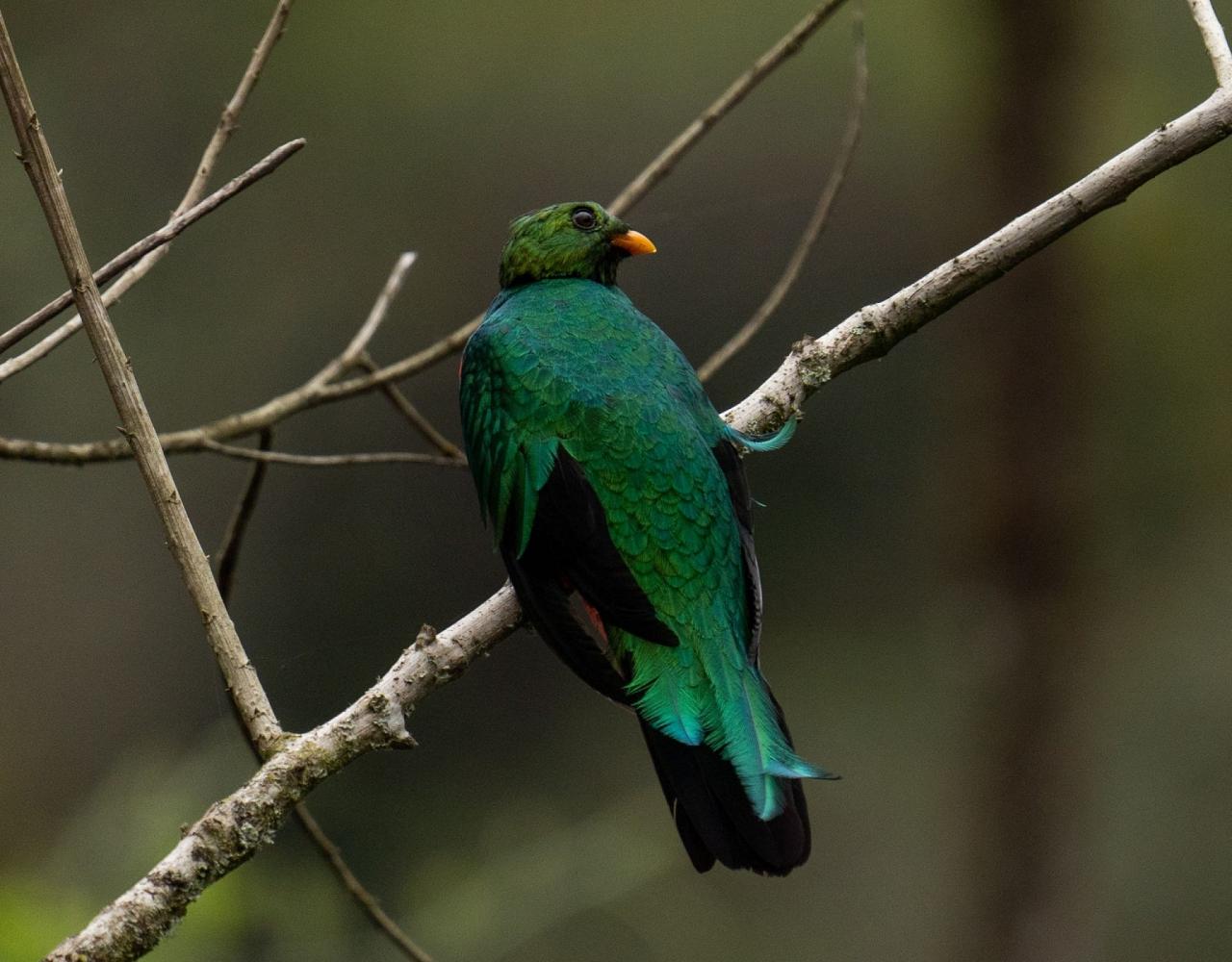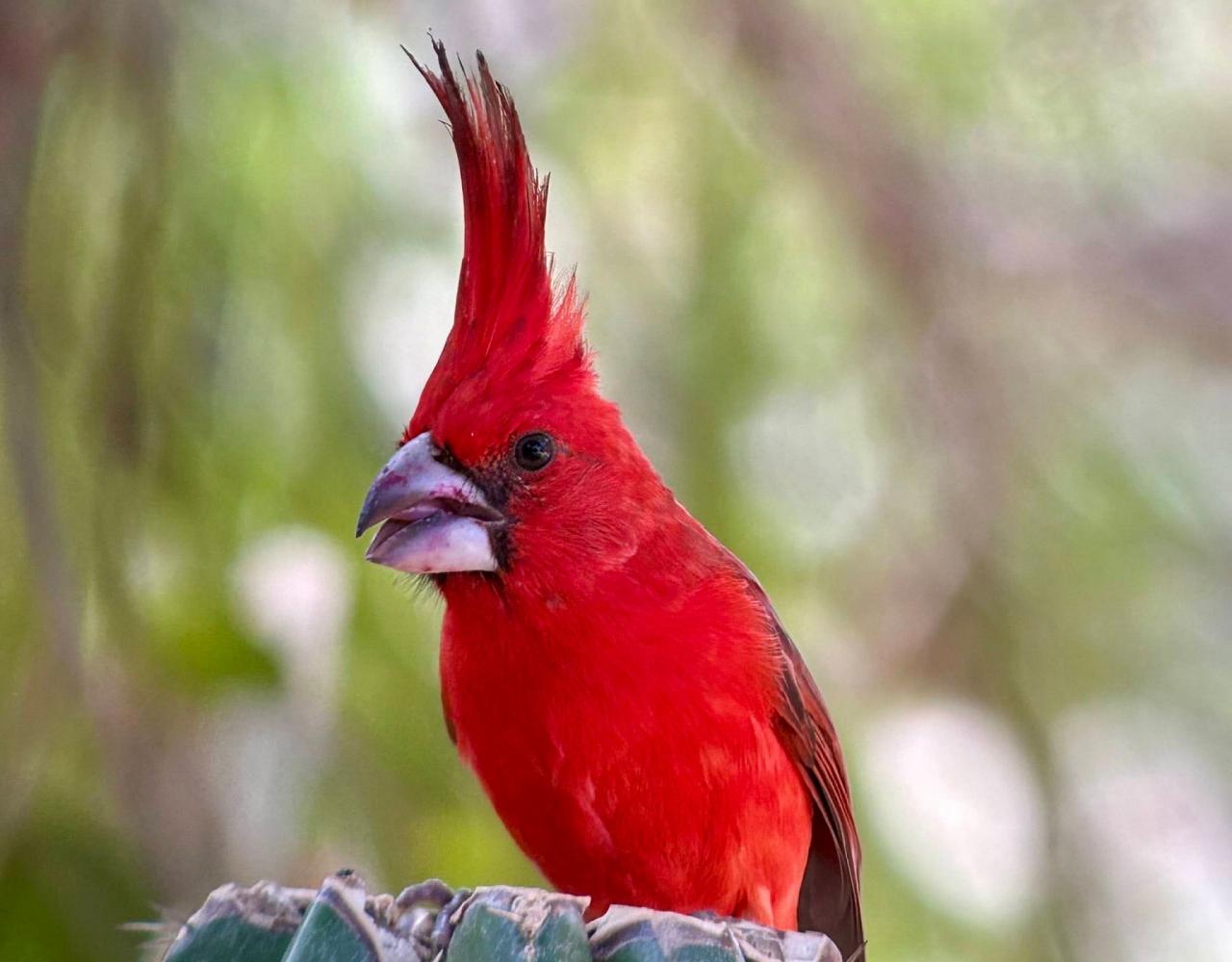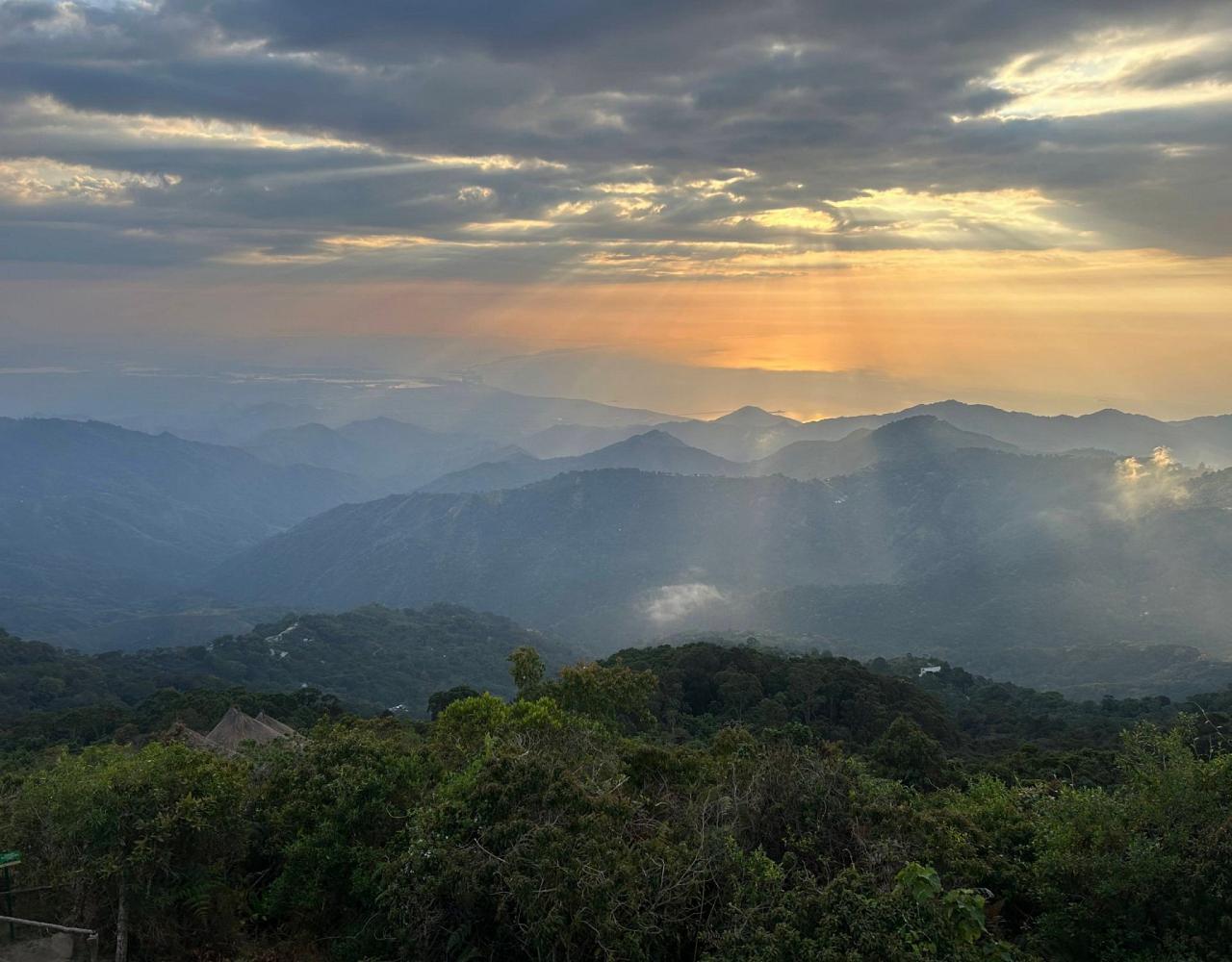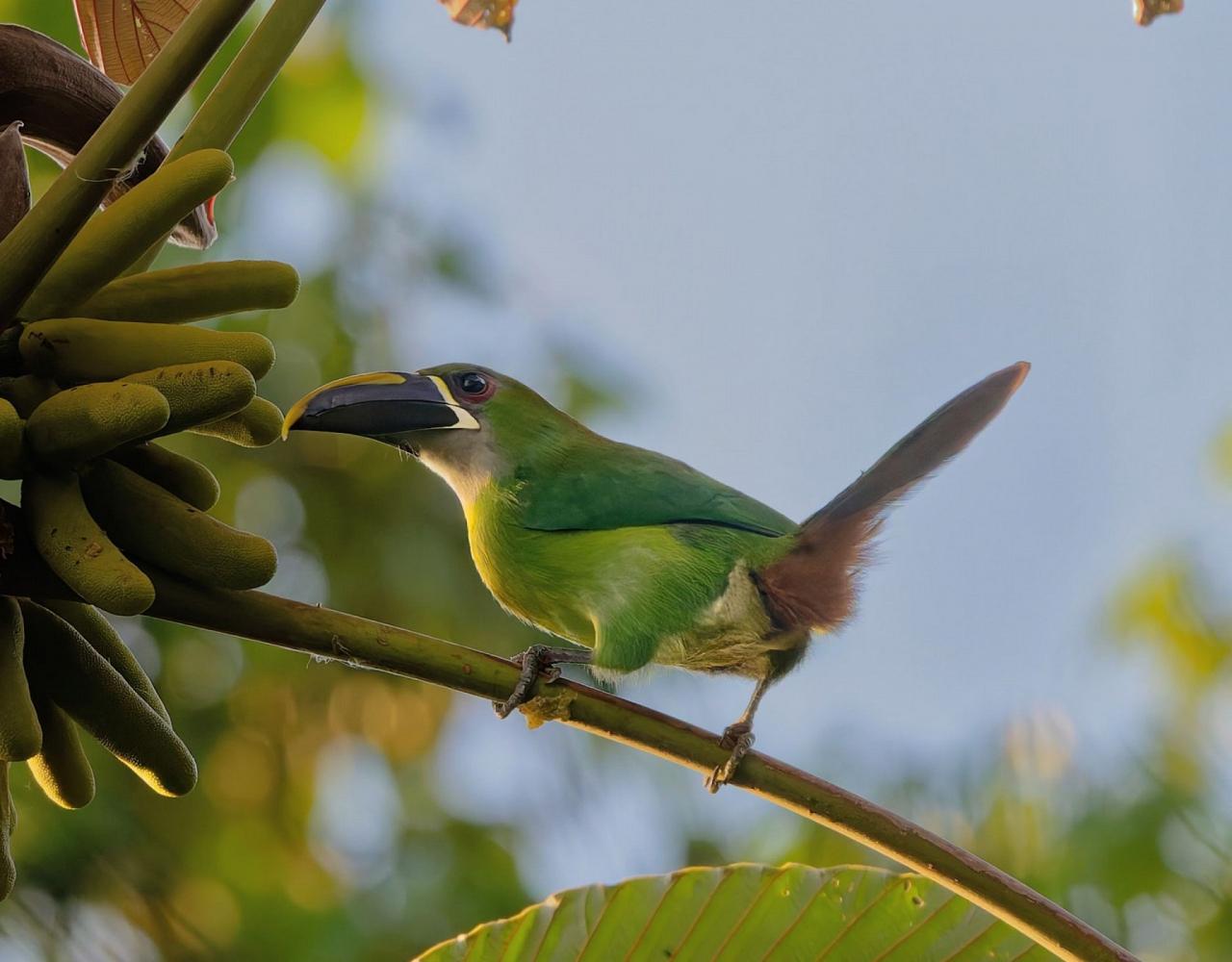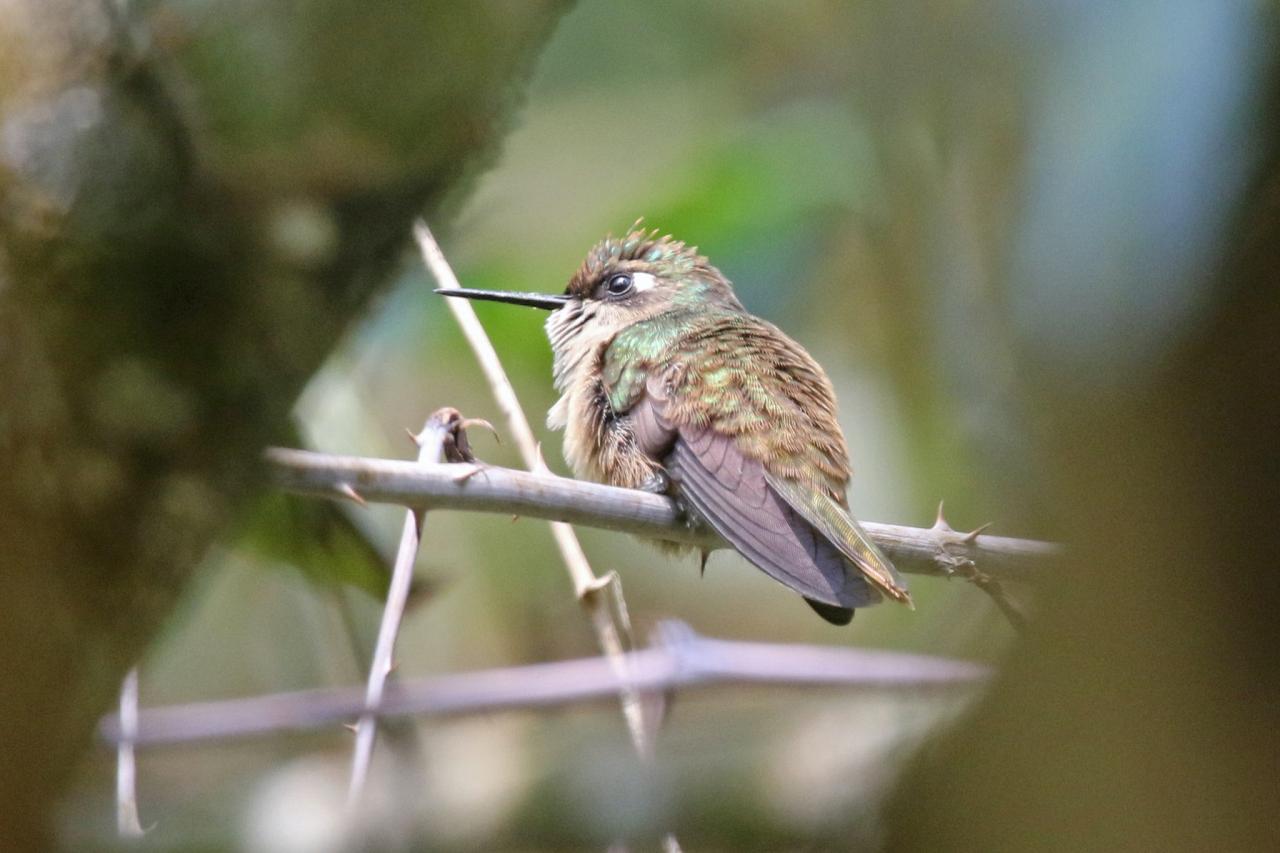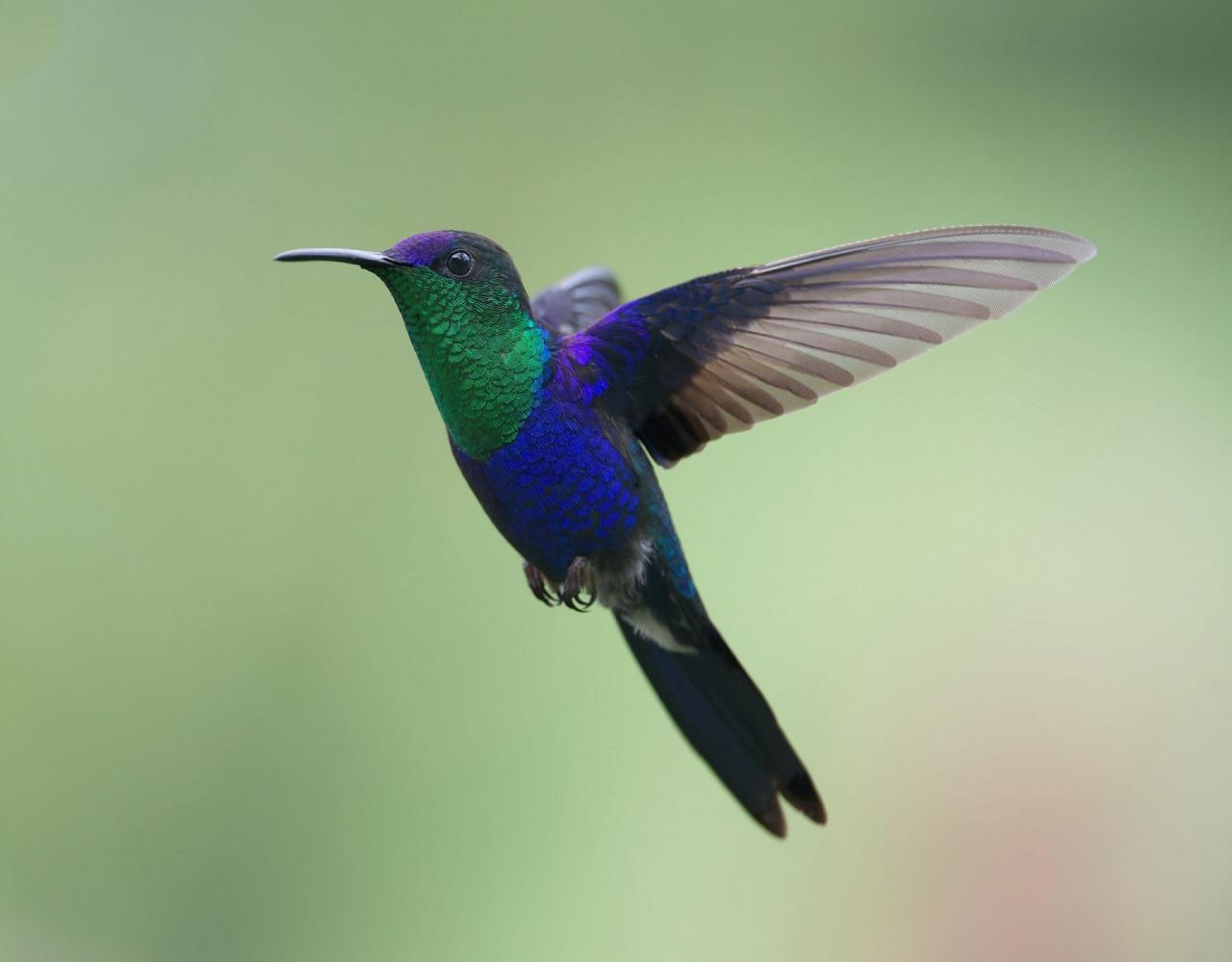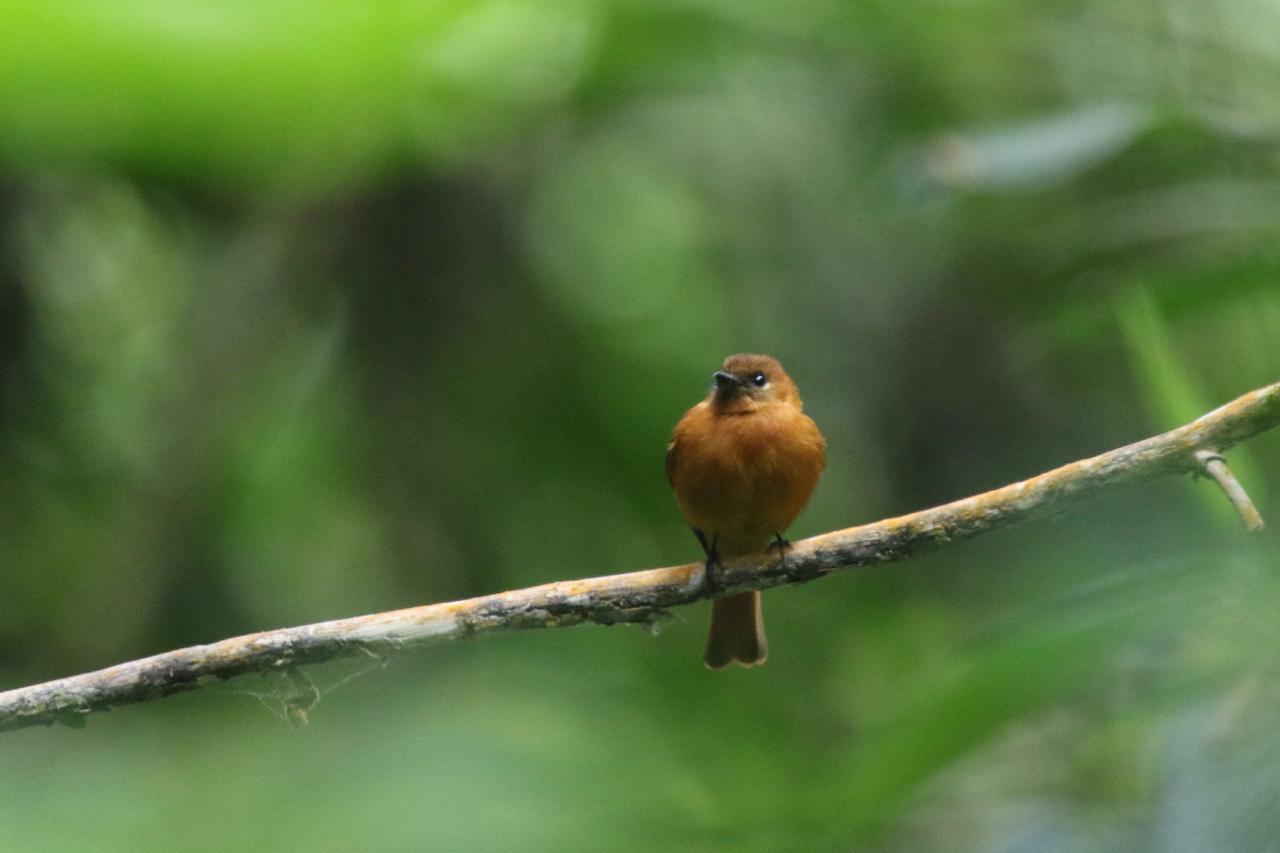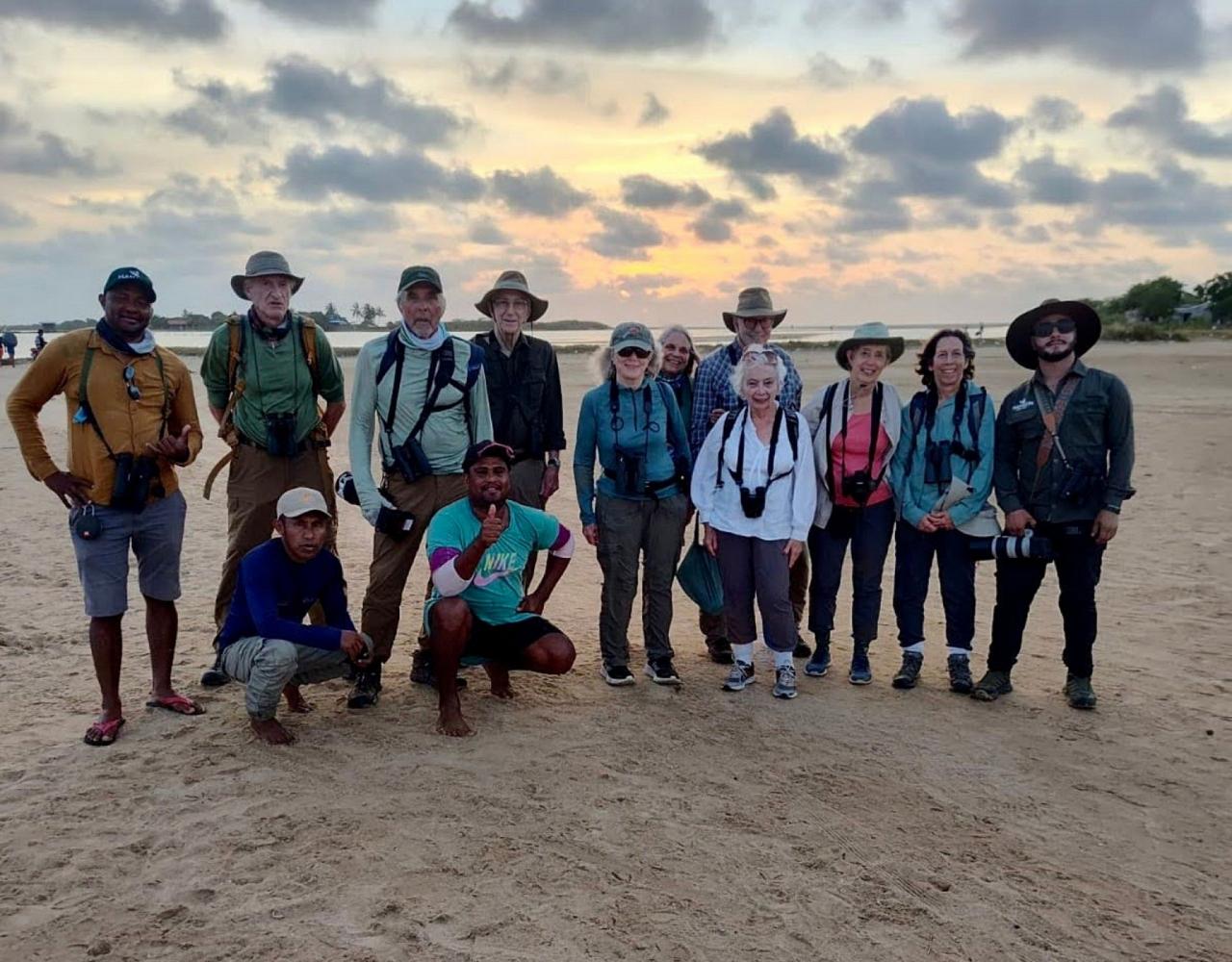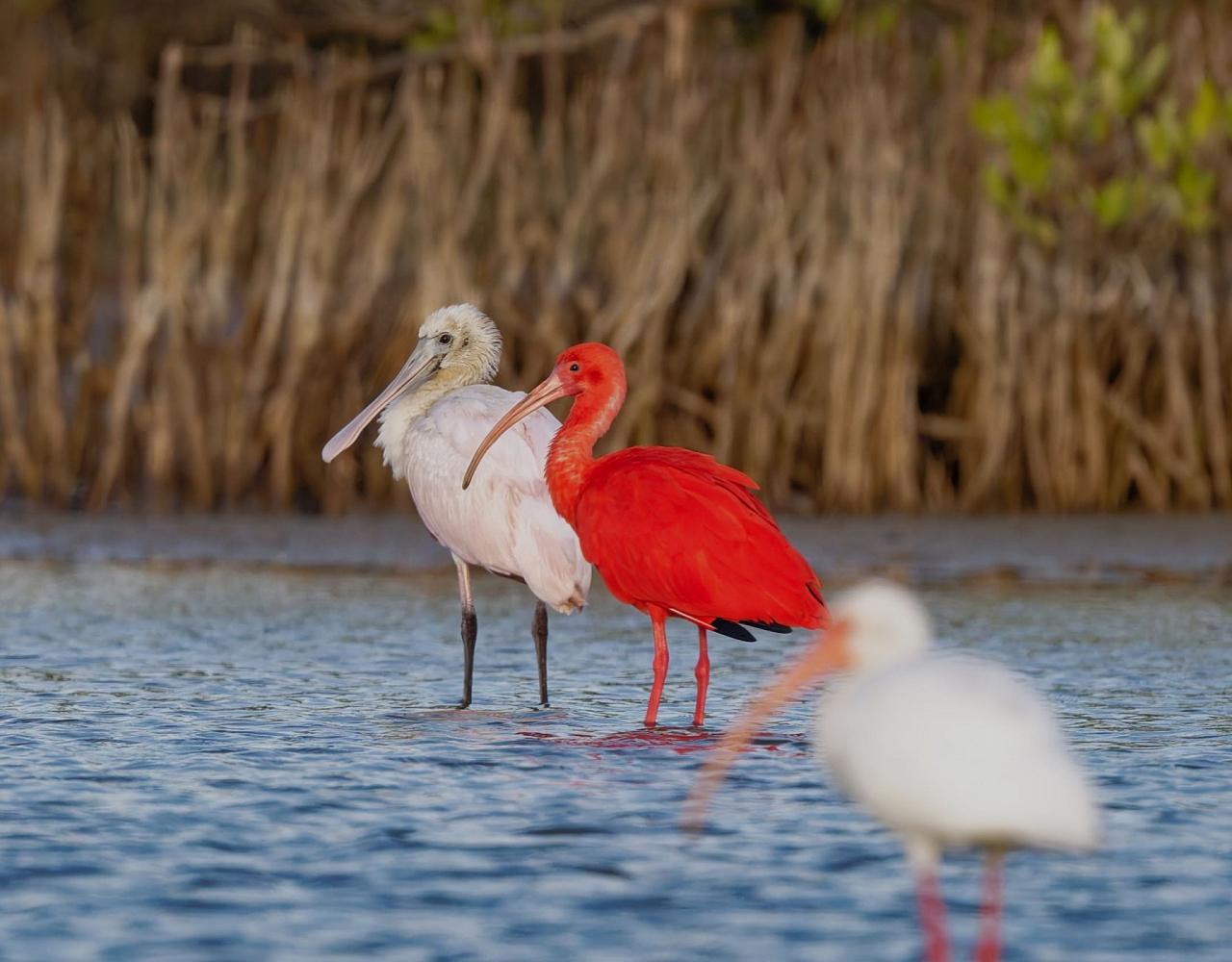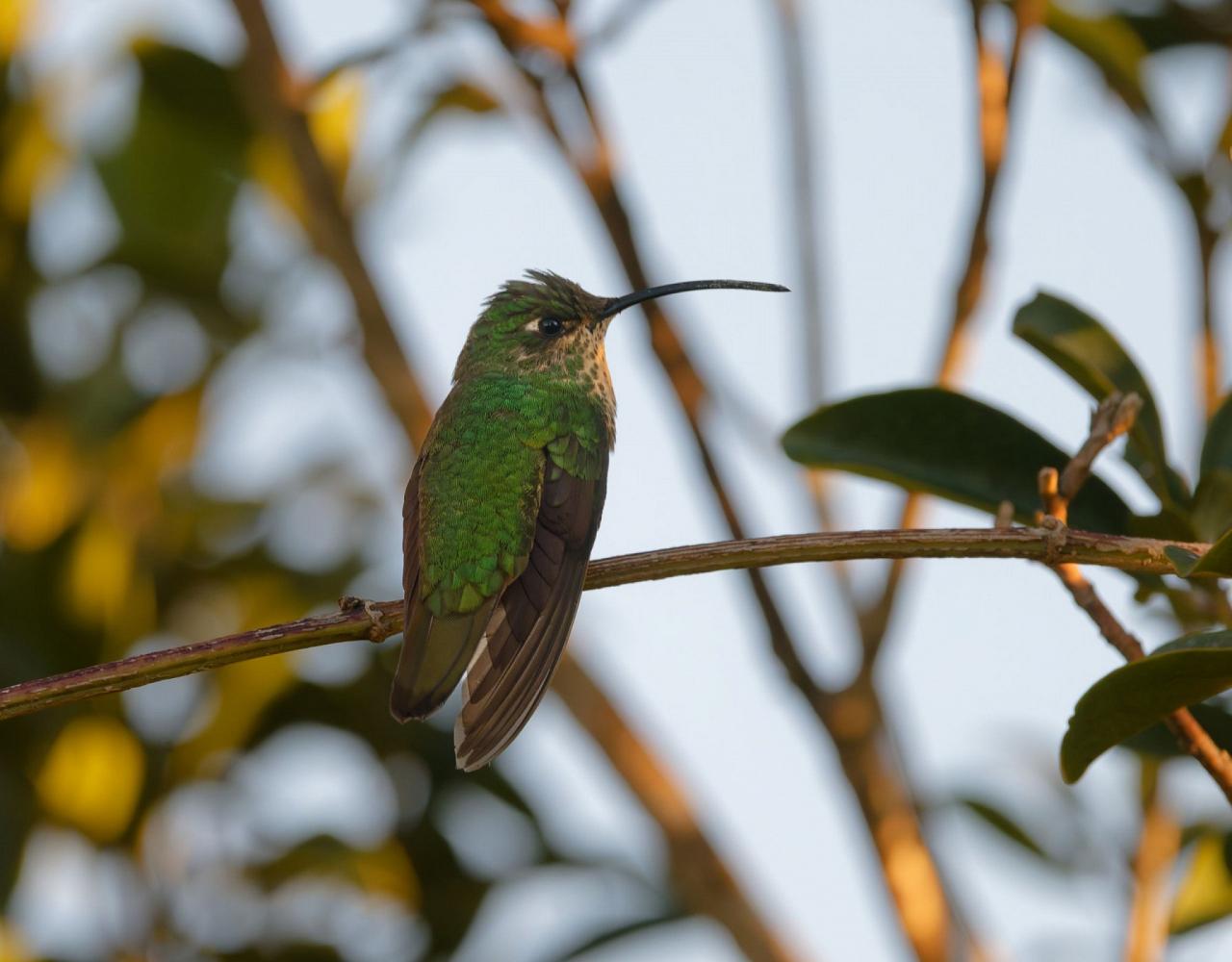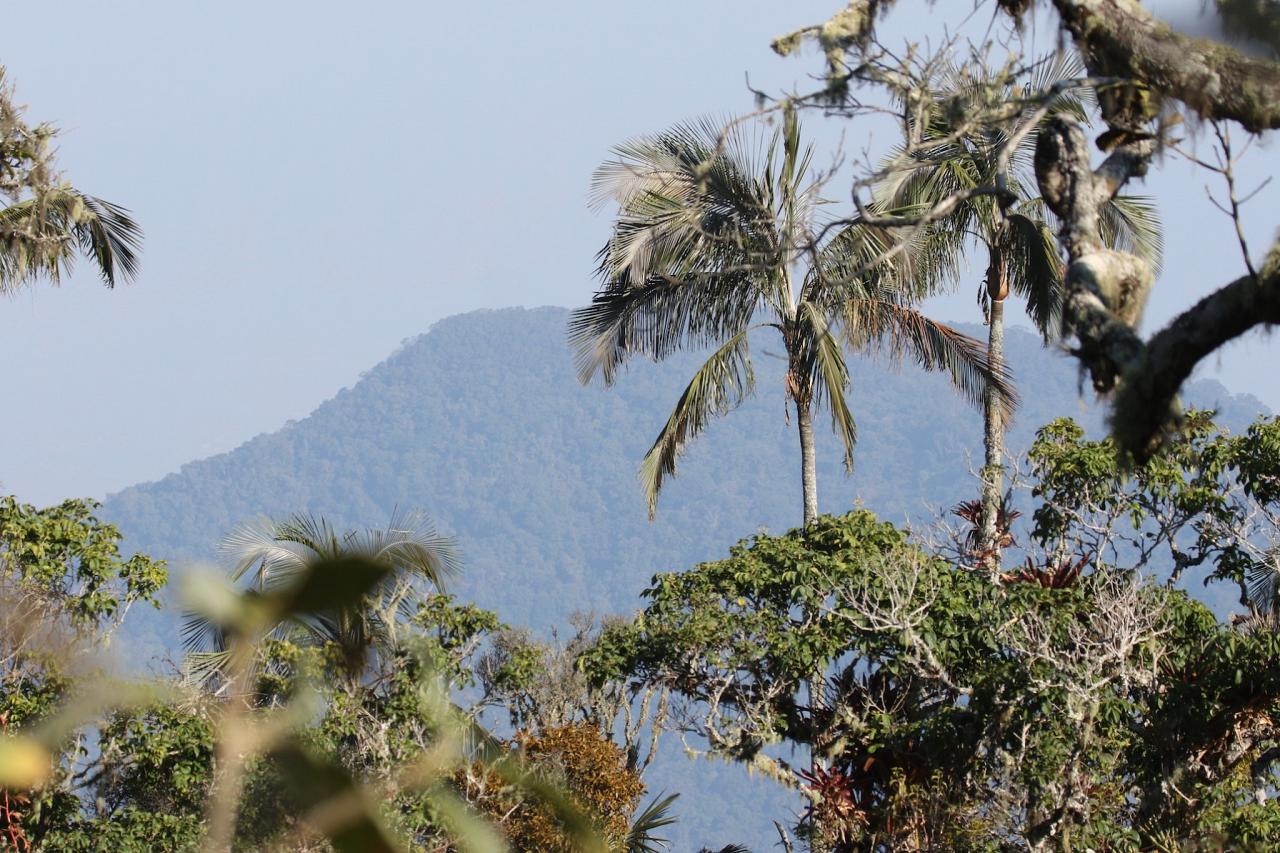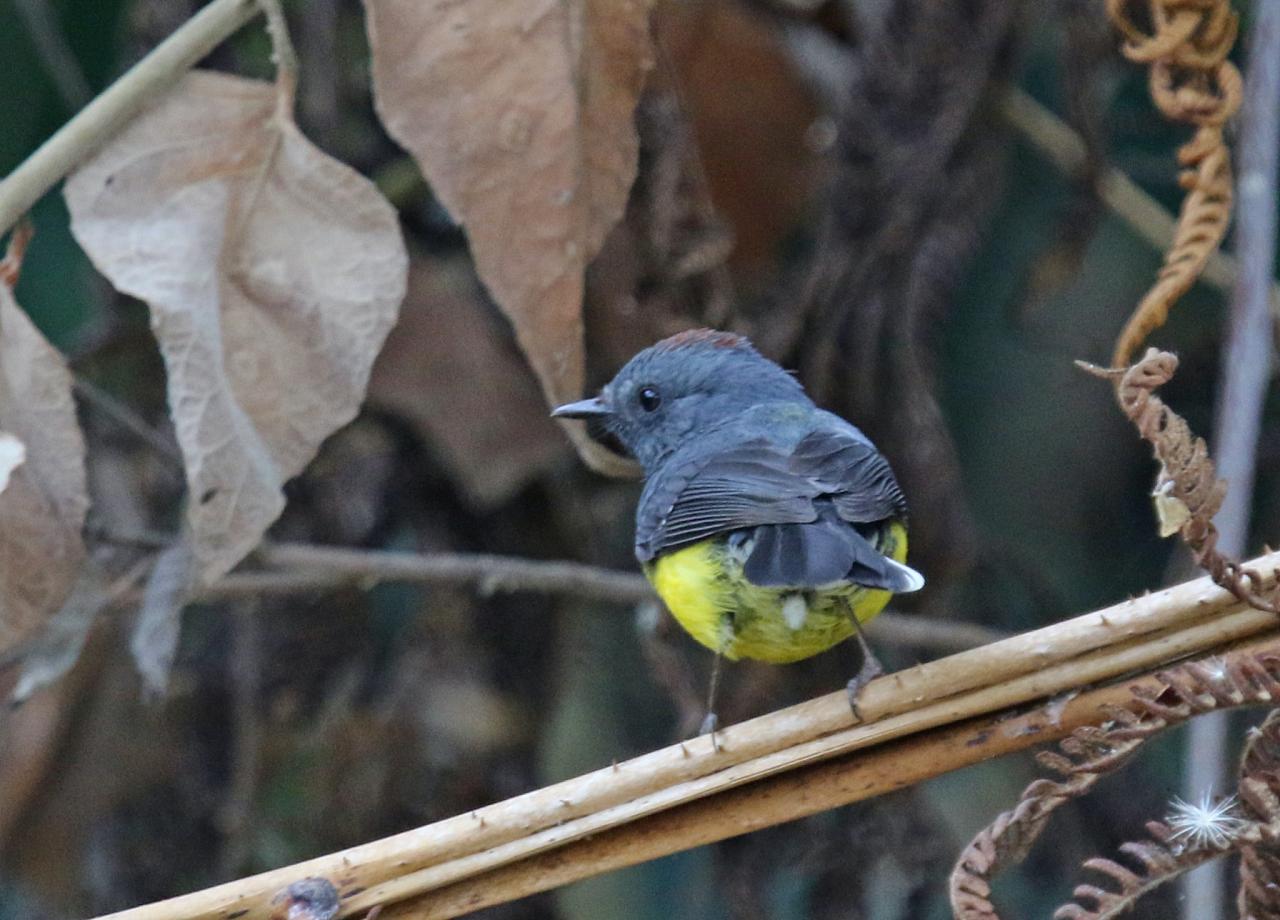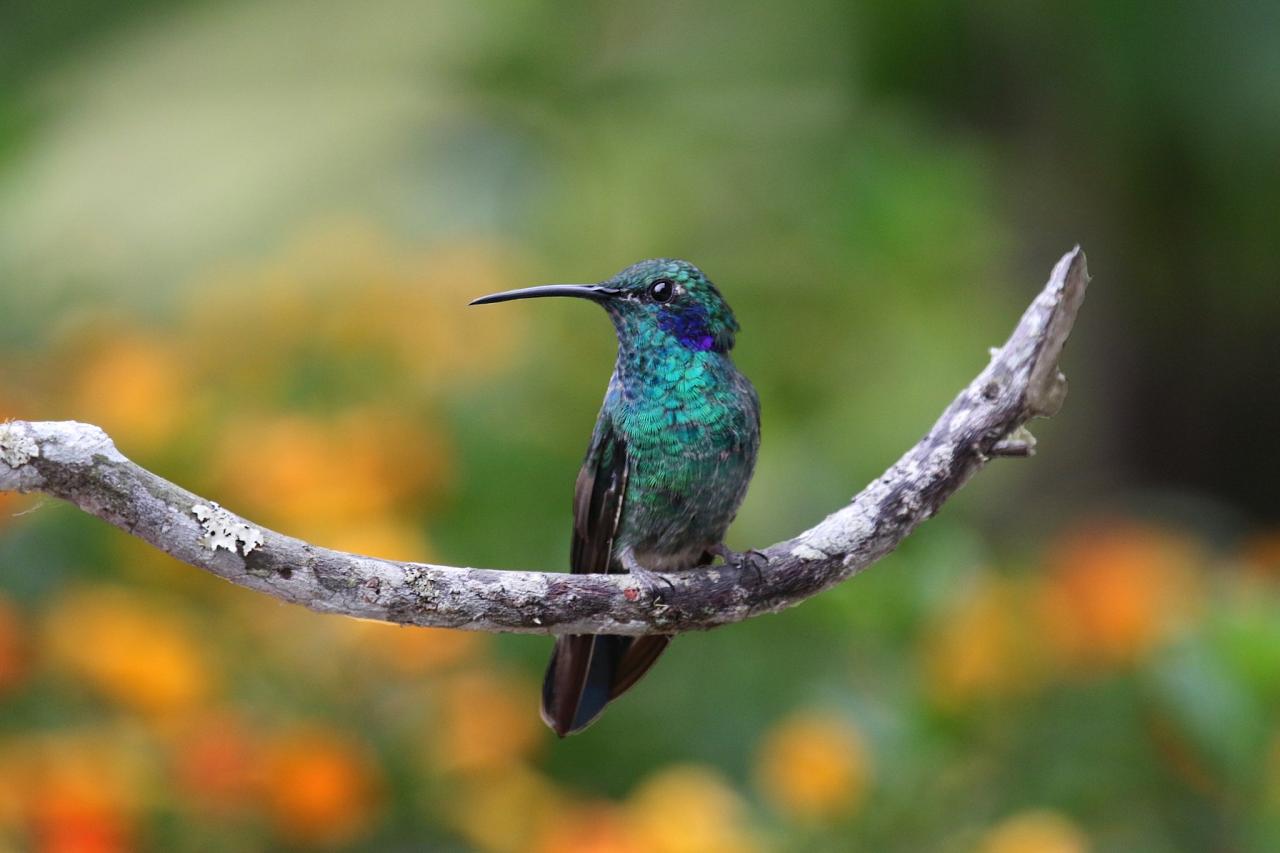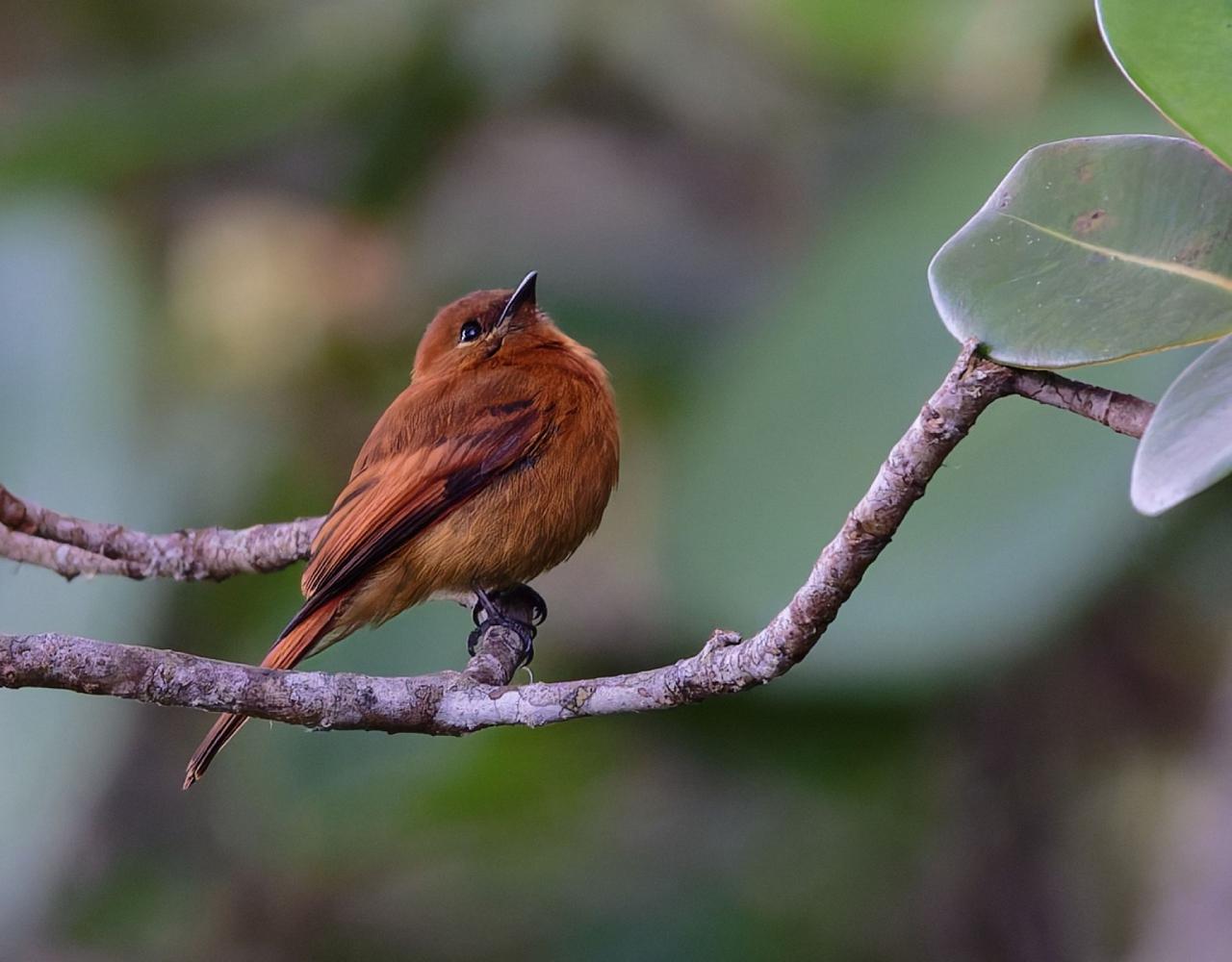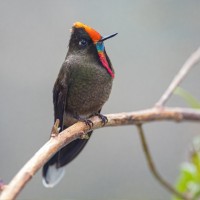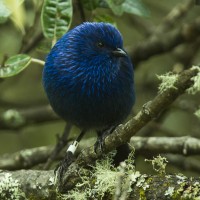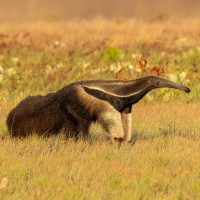- Overview
- Full Itinerary
- Photo Gallery
- Costing
- Travel Details
- Trip Reports
- Guide
- Map
- Know Before You Go
- Other Trips You May Like
Discover the endemic-rich Atlantic Coast of Colombia with Naturalist Journeys, a spectacularly scenic area where palm-lined beaches fringe the skirts of snow-capped summits, with unmatched avian diversity. Colombia’s 1,900+ bird species include exclusively Neotropical families like guans, woodcreepers, ovenbirds, antbirds, puffbirds, toucans, jacamars, manakins, and motmots. Migrant North American songbirds may be seen at any elevation and extensive coastal wetlands offer plentiful waterbirds. This area has incredibly diverse habitats over very short distances and elevational gradients, all of which we sample during this tour.
The lush slopes of the Sierra Nevada de Santa Marta jut up abruptly from the coastline. Isolated from the rest of the Andes by a "sea" of dry forest, these snow-capped mountains have the highest number of endemic birds of any area in Colombia. About 28% (23 species) of Colombia’s endemics occur here, as do at least 39 endemic subspecies. Nearby along the coast, the Tayrona and Los Flamencos National Parks surround the Sierra’s northern face; a ring of Tropical Dry Forest surrounds the massif. Tayrona also offers our first direct immersion in Tropical Moist Forest, directly connected to the Caribbean, while Los Flamencos contains vast lagoons and dry coastal scrub.
With little drive time (the sites are in close proximity), we are left with plentiful opportunities to immerse ourselves in nature. This tour also includes fascinating and unique cultural opportunities, with visits to the fully aquatic (built on stilts in the water) communities of Nueva Venecia (New Venice) and Buenavista. Later in the tour, we visit the ancient homeland of the Wayuu people on the arid Guajira Peninsula. In addition to unique birds and wildlife found nowhere else in Colombia, we have the opportunity to have direct contact with this indigenous community, rich in knowledge, rituals and crafts, who always have a smile and a friendly "AntüshiiJia-Shia", which means "Welcome" in Wayunaiki, the Wayuu's own dialect. We learn about their territory, their homes and communities, their dances, gastronomy, handicrafts, and everything about their culture, their history and their cosmology.
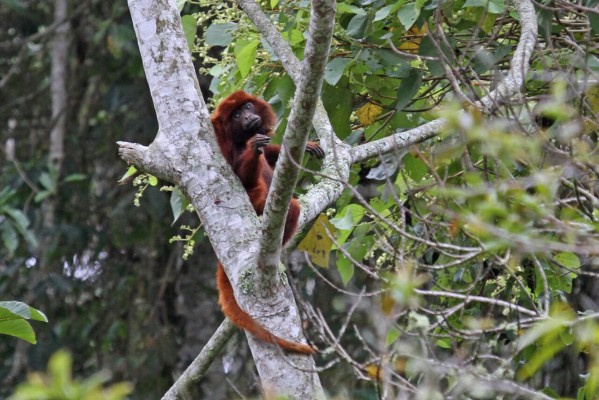
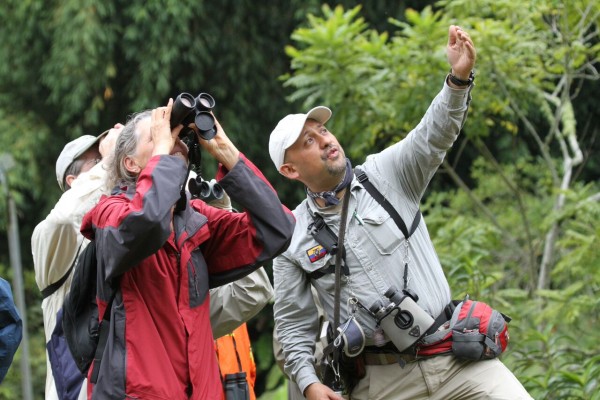
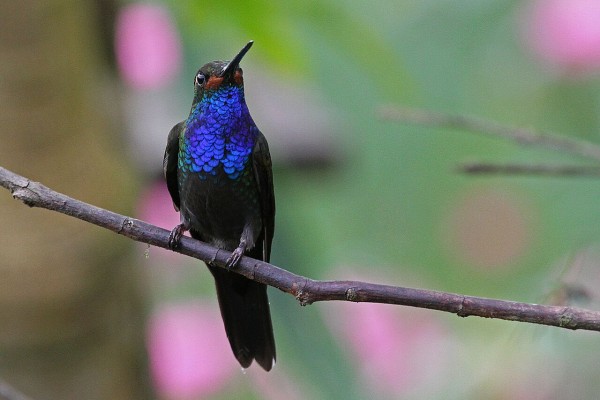
Tour Highlights
- See fabulous birds and wildlife in one of the most beautiful areas of Colombia
- Bird the important coastal lagoons, mangroves, and beaches of the Ciénaga Grande de Santa Marta and Tayrona and Los Flamencos National Parks
- See first-hand the landscapes that so inspired the settings of Nobel Prize winner Gabriel Garcia Marquez’s books such as One Hundred Years of Solitude and Love in the Time of Cholera
- Search for some of the 23 Santa Marta endemic birds, including the Santa Marta Tapaculo, Screech-Owl, Parakeet, Blossomcrown, Brush-Finch, and Warbler and White-tailed Starfrontlet
- Absorb breathtaking sunset views of the ocean and the delta of the Magdalena River from our mountain lodge
- Venture by 4WD atop San Lorenzo Ridge, high above the windswept cloud forest, stronghold for Santa Marta Parakeet and other endemic birds
- Explore coastal dry forest and scrub in Tayrona and Los Flamencos National Parks, some of the last such habitats in Colombia, for Vermilion Cardinal, Buffy Hummingbird, Black-backed Antshrike, and Tocuyo Sparrow
- Watch for mammals like Three-toed Sloth, Nine-banded Armadillo, Cotton-top Tamarin, Gray-handed Night Monkey, White-fronted Capuchin Monkey, and two species of brocket deer
- Visit native and indigenous communities in their villages to see local life, enjoy the cuisine, admire the handicrafts, and support ecotourism
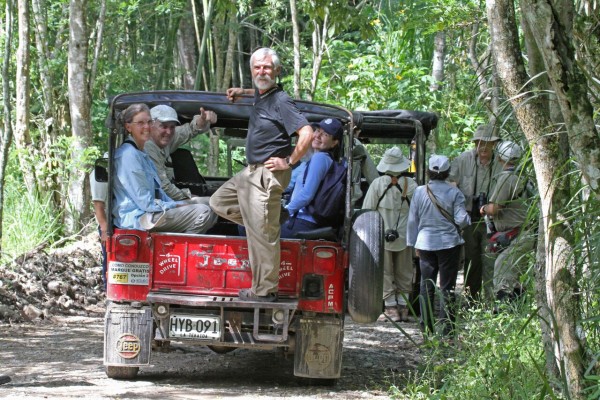

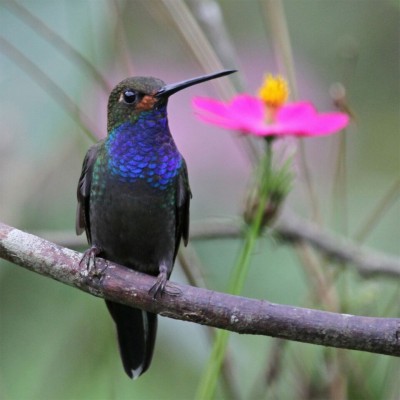
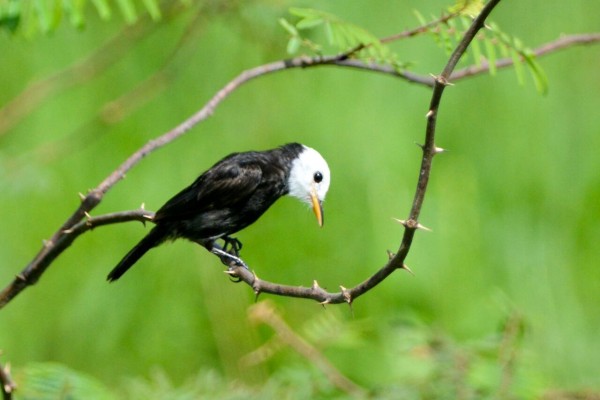
Trip Itinerary
Itineraries are guidelines; variations in itinerary may occur to account for weather, road conditions, closures, etc. and to maximize your experience.
Tues., Mar. 10 Arrivals in Barranquilla
Welcome to Colombia! Arrive today at your leisure at the Barranquilla International Airport (BAQ). A representative from our local operator transfers you from the airport to our hotel in Barranquilla. Dinner tonight is on your own due to varying or late arrival times, but please feel free to get acquainted with others on the tour through an informal dinner.
Accommodations Hilton Garden Inn Barranquilla
Wed., Mar. 11 Palermo | KM 4 Road | Isla Salamanca National Park
After breakfast at our hotel, we begin the day at a local hotspot known as KM 4, located on the outskirts of Barranquilla. It is a rural, flat, and unpaved road that parallels with the Magdalena River, where it was constituted as a zone of water regulation. The area is dominated by secondary growth, shrubs, plantations, and flooded areas that are currently used for local crops and as water reservoirs, making it very a productive location for birds. Many aquatic bird species and others typically found in dry forests inhabit this place. The climate is warm and humid, which is typical of the region that composes the lowlands of the Caribbean. Some of the species we look for include: Russet-throated Puffbird, Pied Puffbird, Stripe-backed Wren, Bicolored Wren, Caribbean Hornero, Yellow-chinned Spinetail, Northern Screamer, Black-bellied Whistling Duck, Limpkin, Cattle Tyrant, Savanna Hawk, Snail Kite, and Large-billed Tern.
Immediately east of Barranquilla, we cross the Rio Magdalena—Colombia’s largest river—that carved the huge valley floor separating the Western and Central Andes. The Magdalena River, Karicali, or Rio Grande de la Magdalena, was the main waterway giving access to mainland Colombia, even before its discovery by Spanish explorers in 1500. In the language of the Karibs, Karicali means River of Caimans.
We then continue to the Isla Salamanca National Park, which is primarily composed of mangrove forests, swamps and exceptional beaches that can be viewed over the road connecting Barranquilla with Santa Marta. This island was declared as an IBA (Important Bird Area) and is next to the Ciénaga Grande de Santa Marta. In 1998, the Ciénega was declared as a Ramsar wetland of global importance, and in November of 2000, as a Biosphere Reserve by UNESCO. The island of Salamanca is in reality part of a group of small islands formed by the accumulation of sediments arriving from the delta of the Magdalena, linked together by small canals to integrate a barrier that separates the Ciénaga Grande from the Caribbean Sea.
We stop at the Cocos visitor center inside the park to walk through mangrove forest in search of one of the rarest birds in Colombia: the enigmatic and endemic Sapphire-bellied Hummingbird (separated with care from the co-occurring Sapphire-throated Hummingbird). Other birds here include Bare-eyed Pigeon, Red-rumped Woodpecker, Brown-throated Parakeet, Northern Scrub-Flycatcher, Black-crested Antshrike, Bicolored Conebill, Bronzed Cowbird, and the rare Chestnut Piculet. As we drive by the marshes, we look for Lesser Yellow-headed Vulture, Snail Kite, and Limpkin, among many other waterbirds that abound here.
As the day warms, we explore the park’s wetlands, where bird communities vary by month and water level. We look for Fulvous and Black-bellied Whistling-ducks, Cinnamon Teal, White-cheeked Pintail, Black-necked Stilt, several sandpipers, gulls, plovers, Black-collared Hawk, Glossy Ibis, Roseate Spoonbill, and two delightful flycatchers: Pied Water-Tyrant and White-headed Marsh-Tyrant.
Accommodations at GHL Costa Azul (B,L,D)
Thurs., Mar. 12 Ciénega Grande de Santa Marta | Nuevo Venecia | Buenavista | Minca
Today we bird our way to our comfortable hotel in Palomino. We drive Coastal Route 90. At the time of construction, the road’s foundations between Barranquilla and the Ciénaga Grande changed the mix of salty and sweet water in the area, negatively impacting 56,000 hectares of marshes of the Ciénaga Grande de Santa Marta. This sad event modified the natural dynamic of the mangroves and the marshes but left a perfect birding drive with views over both the Caribbean and the Ciénaga Grande allowing us to search for marine, estuarine, and dry forest birds.
Reminiscent of the Everglades, Ciénaga Grande de Santa Marta is a UNESCO Biosphere Reserve and Ramsar designated wetland, presenting the most extensive array of estuarine habitats and ecosystems in northern South America. However, in spite its importance, the reserve only covers 268 sq km?6% of the total marsh area. Its biological features have shaped the life and culture of humans for millennia. In fact, one of the two first records of early ceramics in the Americas was discovered here.
As part of our visit to the Ciénega Grande de Santa Marta, we visit the towns of Nueva Venecia and Buenavista—towns literally built over water. This is one of the few areas in the world where such towns?villages built completely over water using stilts?still exist. These communities rely mainly on fishing, but now they are also working with tourism and when we visit these communities we are able to learn about their way of life as literal “aquatic communities,” their fishing, gastronomy, music and dances, and handicrafts, all surrounded by incredible nature. The entire area looks like an illustrated landscape, a Colombian “magical realism” image, a town straight out of the imagination of Gabriel García Márquez.
As time permits, we stop at several small wetlands, either salt flats or patches of mangroves, scanning for wintering shorebirds and waders. Species like Semipalmated, Spotted, and Western Sandpipers and Willet are familiar; others like Collared Plover may be new. Wilson’s Plover and Short-billed Dowitcher are generally present in good numbers and we should see a number of terns, including Gull-billed, Royal, Sandwich, and the large and showy Caspian. A real treat: Roseate Spoonbill, storks, and Jabiru feeding in saline pools; Brown Pelican abound, and Magnificent Frigatebird are usually present over the beach. Brown-throated Parakeet often come in flocks, sometimes swooping over roosting Black Skimmer, Little Blue and Tricolored Herons, and American Flamingo.
As we travel through drier habitat with cactus and huge shrubs of the introduced Giant Milkweed or Sodom’s Apple, we watch for Crested and Yellow-headed Caracaras, Harris’s Hawk, American Kestrel, Russet-throated Puffbird, and the endemic Chestnut-winged Chachalaca perched on cacti at day’s end.
Accommodations at Finca La Jorará Eco Hotel (B,L,D)
Fri., Mar. 13 Tayrona National Park
This morning, we explore Tayrona National Park, nestled along the Caribbean coastline. This hidden gem of lush, tropical forest is home to a variety of species we hope to see, including the critically endangered Cotton-top Tamarin. These adorable primates, which are only found in northwestern Colombia, weigh less than one pound and are named for the shock of white hair on the top of their head. In addition to tamarin, we hope to see the endemic and critically endangered Blue-billed Curassow.
We explore two different areas in the park that are different, but equally enchanting. The main area of the park, off the main road, offers convenient access to a variety of bird habitats. The serene Gaviotas area within the park offers less visited paths and a more tranquil setting. Birds we hope to see in these areas include Rufous-vented Chachalaca, Ruby-Topaz Hummingbird, White-chinned Sapphire, Whooping Motmot, White-necked Puffbird, Chestnut Piculet, Green-rumped Parrotlet, Military Macaw, Black-crested Antshrike, Lance-tailed Manakin, Sepia-capped Flycatcher, Brown-capped Tyrranulet, Golden-fronted Greenlet, Bicolored Wren, and Trinidad Euphonia.
In the afternoon, we have time to relax at the hotel where you can enjoy the beach, take a dip in the natural pools, bird along the trails and lush grounds, or just relax!
Accommodations at Finca La Jorará Eco Hotel (B,L,D)
Sat., Mar. 14 La Jorara | Gaviotas Road | Transfer to Riohacha
Today we continue heading east, toward the coastal town of Riohacha. Gaviotas Road is located in the outskirts of Tayrona National Park and is flat and in good condition with good nice variety of ecosystem for us to explore including open livestock fields, secondary growth forest and patches of primary tropical humid forest ending at the beach (yes!). Because of this variety the birding is quite easy and usually very productive; over 200 species have been recorded here, including Caribbean lowland specialties.
Our top species include Lance-tailed Manakin, White-bellied Antbird, White-vented Plumeleteer, Steely-vented Hummingbird, Collared Aracari, Golden-olive, Lineated and Crimson-crested Woodpecker, Black-headed Tody-Flycatcher, Orange-chinned Parakeet, Cinereous, Cinnamon and White-winged Becards, Masked Tityra, Black-chested Jay, Golden-fronted Greenlet, Brown-capped Vireo, Crimson-backed Tanager, Streaked and Grayish Saltators, Lesson's Seedeater, Yellow-backed Oriole, Crested Oropendola, and Trinidad Euphonia.
Accommodations at at Hotel Guajira Casa del Mar (B,L,D)
Sun., Mar. 15 Los Flamencos National Reserve
Located about 25 minutes away from Riohacha, the Los Flamencos National Reserve was primarily created to protect the American Flamingo population that inhabits the beaches. Surrounded by dry forests and coastal wetlands, this protected location is an IBA (Important Bird Area) due to having more than 400 recorded bird species; most of them are of coastal origin migrating from the north side of the continent. This sanctuary is an easy place for bird observation, where it is possible to spot species that are only found here and cannot be found anywhere else in Colombia. Although the temperatures tend to be very high, the strong winds help to make it more refreshing. Not only is it a pleasant spot for the observation of birds, but it also provides incredible local seafood for our meals.
In addition to the lagoons and coastal wetlands, we spend some time exploring the surrounding coastal dry scrub, which harbors many unique birds. Some of the highlight species we look for during the day are Chestnut Piculet, White-whiskered Spinetail, Slender-billed Tyrannulet, Tocuyo Sparrow, Vermilion Cardinal, Pearl Kite, Aplomado Falcon, Bare-eyed Pigeon, Brown-throated and Blue-crowned parakeet, Green-rumped Parrotlet, Burrowing Owl, Red-billed Emerald, Buffy Hummingbird, Rufous-tailed Jacamar, Russet-throated Puffbird, Red-crowned Woodpecker, Straight-billed Woodcreeper, Caribbean Hornero, Pale-breasted Spinetail, Black-crested and Black-backed Antshrike, White-fringed Antwren, Northern Scrub-Flycatcher, Pale-eyed Pygmy-Tyrant, Pearly-vented Tody-Tyrant, Brown-crested and Venezuelan Flycatcher, Streaked Flycatcher, Bicolored Wren, Black-chested Jay, Tropical Gnatcatcher, Scrub Greenlet, Glaucous Tanager, Black-faced Grassquit, Pileated Finch, Grayish, Buff-throated and Orinocan Saltators, and Yellow Oriole.
Accommodations at Hotel Guajira Casa del Mar (B,L,D)
Mon., Mar. 16 Los Flamencos National Reserve | Wayuu Communities
Today is a bit flexible, depending on what we have seen on the prior days. We may make a return visit to a different part of Los Flamencos in search of things we missed or better looks at some species.
Later in the morning, we visit the local Wayuu communities. The Wayuu inhabit the arid Guajira Peninsula of Colombia and adjacent Venezuela. We have the opportunity to have direct contact with this indigenous community, rich in knowledge, rituals, and crafts. We learn about their territory, their homes and communities, their dances, gastronomy, handicrafts and everything about their culture, their history and their cosmology.
We then travel west along the coast, admiring the spectacular views of the Sierra Nevada on one side and the Caribbean on the other, we stop at Tayrona National Park, named after the indigenous people who formerly inhabited the region. The various trails, beaches, and main road of Tayrona offer many opportunities to look for forest species, perfectly complementing our time in the Sierra Nevada. Tayrona protects coral reefs, beaches, bays, and important samples of unique coastal vegetation directly related to the ecosystems and geological formations on the northern slopes of the Sierra Nevada. Because of its biogeographical importance, UNESCO declared the Park to be part of the Sierra Nevada de Santa Marta Biosphere Reserve in 1982. The western section of the reserve is Tropical Moist Forest, an isolated coastal extension of this vegetation formation that wedges itself between sections of the Tropical Dry Forest of the Colombian Caribbean.
This rich diversity of flora shelters unique bird species, including the ultra-rare endemic Blue-billed Curassow, Crested Guan, Crimson-crested Woodpecker, Keel-billed Toucan, Yellow-billed Cuckoo (only during migration), Rufous-breasted Hermit, Western Long-tailed Hermit, Sooty-capped Hermit, White-chinned Sapphire, White-necked Puffbird, Cocoa Woodcreeper, Red-billed Scythebill, Western-Slaty Antshrike, Jet Antbird, Northern White-fringed Antwren, White-bellied Antbird, Lance-tailed Manakin, Southern Bentbill, Yellow-breasted Flycatcher, Golden-fronted Greenlet, Gray-headed Tanager, Carib Grackle, and Yellow and Orange-crowned Orioles. We also hope to find White-fronted Capuchin and the critically endangered Cotton-top Tamarin, which inhabit these forests.
By afternoon, we ascend to approximately 6,000 feet, arriving at El Dorado Reserve, administered by the
environmental organization, Fundación ProAves. We should arrive with sufficient daylight remaining so that we can enjoy the fruit and hummingbird feeders outside the restaurant. Here we look for endemic Black-backed Thornbill, White-tailed Starfrontlet, and Santa Marta Brush-Finch, plus calling White-tailed Trogon. The lodge overlooks extensive gardens and active hummingbird feeders. Each cabin has a private bath, hot water, and sufficient outlets for charging your camera or laptop. The setting and its splendid views are quite remarkable!
Birding the lodge grounds is productive; endemic White-tailed Starfrontlet joins the numerous violet-ears, Violet-crowned Woodnymph, and Tyrian Metaltail (an endemic Santa Marta subspecies) at the hummingbird feeders. Black-fronted Wood-Quail are attracted to seed and the lodge’s compost pile, Santa Marta Brush-Finch are common, Stripe-headed Brush-Finch may be seen in the bushes surrounding the lodge, and occasionally Santa Marta Antpitta are seen outside the restaurant. Even the extremely rare Santa Marta Sabrewing has been seen on the lodge grounds and Lined Quail-Dove are frequently heard (but difficult to see). During a recent visit, two Band-tailed Guan were perched outside one of our cabins and a Santa Marta Screech-Owl called outside of another. We have the opportunity to look for the day roost of this owl during our stay.
Accommodations at El Dorado Lodge (B,L,D)
Tues., Mar. 17 Sierra Nevada de Santa Marta: San Lorenzo Ridge
We have a very early start today to catch the sunrise at the top of the ridge. Our goal is to be there and ready by the time all the specialties wake up, particularly small flocks of Santa Marta Parakeet, one of Colombia’s most endangered parrots. Space is not ample and the road is narrow; birding groups have one shot during their stay at El Dorado to explore the top of the mountain unless there are no others trying for the summit.
The ride uphill in four-wheel drive vehicles (on what some have referred to as a “road”) takes us to the San Lorenzo Ridge, one of the only vehicle-accessible areas in the upper part of the Sierra Nevada de Santa Marta National Park. Recognizing the area’s unique character, the Colombian government designated much of the Sierra Nevada as Colombia’s second National Park in 1964. If the morning is clear, we are able to see the highest snow-covered peaks of the Sierra Nevada (in fact, the highest in the entire country!) towering far to the south above the windswept Cloud Forest. A stretch of mostly flat road, lined with ferns, bamboo, sprawling club mosses, and melastome shrubs harbors a number of very local specialties, as well as some more widespread birds including Santa Marta Antpitta, Sierra Nevada Antpitta, Brown-rumped Tapaculo, Rusty-headed Spinetail, Flammulated Treehunter, Yellow-bellied Chat-Tyrant, Santa Marta Bush-Tyrant, Santa Marta Warbler, some easier endemics such as Yellow-crowned Redstart, Black-cheeked Mountain-Tanager, and curious Santa Marta Brush-Finch that are more confiding than the ones at the lodge.
The low, open woodland is home to Southern Emerald-Toucanet, Santa Marta Mountain-Tanager, Yellow-crowned Redstart, Santa Marta Warbler, White-throated Tyrannulet, Hermit Wood-Wren, Strong-billed Woodcreeper, and a number of other species. We might be lucky and find Santa Marta Sabrewing.
Butterflies here include several interesting species of small, dark satyrs and a few skippers that have adapted to these higher, cooler habitats. Today’s altitudinal range is between 7900 and 8900 feet along the last 1.5-mile stretch of road to the Antenas-Cerro Kenedy area. Above 8200 feet the vegetation changes; the rains are diminished here but the presence of clouds and fog increases. These different environmental conditions support a different set of plant species, defined as Montane Wet Forest. Our guide shows us some of the representative plant species, including Chusquea bamboo thickets and dense shrubbery.
Accommodations at El Dorado Lodge (B,L,D)
Wed., Mar. 18 Sierra Nevada de Santa Marta: El Dorado Nature Reserve
The dirt road that passes the lodge provides easy walking access through moist Subtropical Wet Forest. This kind of forest is present between 4950 to 8250 feet, and has an annual average rainfall of 79 to 158 inches. Vegetation is increasingly lush and we feel moisture in the air. Morning temperatures can be a cool 62°F.
As we drive uphill from the lodge this morning, we explore between 5280 and 6270 feet at our leisure. Here tree ferns are seen frequently, as well as epiphytes, lianas, and veins. We look for some of the previous days’ birds that we might have missed. Mixed flocks are likely perched on palms (Arecaceae) like Dictyocaryum lamarckianum and Socratea at lower altitudes. Strolls may yield a variety of species including Santa Marta Antpitta, Groove-billed Toucanet, Rusty-breasted Antpitta, Golden-breasted Fruiteater, Santa Marta Tapaculo, White-lored Warbler, Masked Trogon, the rather local White-tipped Quetzal, Black-throated Tody-Flycatcher, Cinnamon Flycatcher, the endemic Streak-capped Spinetail, Montane and Strong-billed Woodcreepers, Slate-throated Redstart, Blue-capped Tanager, Blue-naped Chlorophonia, and Black-hooded Thrush. As we explore the mountain, we also hope to hear (and see!) Venezuelan Red Howler Monkey and Gray-handed Night Monkey, in addition to the easier to spot Black Agouti and Red-tailed Squirrel.
Depending on yesterday’s findings we could go a bit higher, up to 7600 feet, surrounded by temperate forest vegetation. We might try again for any of the Santa Marta endemics that we have previously missed. Vegetation includes taller trees (above 70 feet in height) with buttresses and a habitat with denser undergrowth. This is the Subtropical Wet Forest. After the Tropical Dry Forest, the Subtropical Wet Forest is the next most endangered vegetation formation in Colombia. Within this altitudinal range, there are 19 endemic flowering plants with restricted distribution in these mountains. An additional group of 21 species endemic to this mountain is present in higher and lower elevations as well. This Subtropical Wet Forest also harbors a third of the 126 endemic flowering plant species reported in the Santa Marta Mountains.
As we return to our lodge, we have a chance to catch the breathtaking view of the sunset over the ocean and along the Magdalena Delta. A past client stood silently as the sun set, then said “I don’t think the video camera will be able to record this.”
Accommodations at El Dorado Lodge (B,L,D)
Thurs., Mar. 19 El Dorado Nature Reserve | Minca | Transfer to Barranquilla
This morning’s first hours are devoted to looking for Tropical Dry Forest species around Minca and those from yesterday that we might have missed at the feeders. Local possibilities include Scaled Piculet, Collared Forest-Falcon, Lazuline Sabrewing, Pale-eyed Pygmy-Tyrant, Cinereous Becard, Rufous-breasted Wren, Rufous-and-white Wren, Dull-colored Grassquit, Thick-billed Seed-Finch, Crimson-backed Tanager, and the beautiful Golden-winged Sparrow.
Our drive back to Barranquilla includes a lunch stop near the historic town of Santa Marta. Santa Marta is not only the capital of Magdalena Department, but also the first Spanish settlement in Colombia and the second oldest city in South America, founded in 1525 by Rodrigo de Bastidas. Santa Marta is where Simon Bolívar passed away on his way to exile in Europe on December 17, 1830, and where he wanted to have his heart buried at the Cathedral as an expression of his love for this land. Bolívar is known today as the Great Liberator since he led the fight for independence from Spain for Venezuela, Colombia, Ecuador, Peru, Bolivia, and Panama.
We make an early return to our hotel in Barranquilla today, to allow time to rest and clean up and begin packing. We then conclude the tour with a farewell dinner in Barranquilla to celebrate our great sightings, companionship, and memories of our time on the Atlantic Coast of Colombia.
Accommodations at Hilton Garden Inn Barranquilla (B,L,D)
Fri., Mar. 20 Departures
Depart at your leisure for home or your final destination from Barranquilla (BAQ). Transportation to the airport is provided in time for your flight.
Cost of the Journey
The cost of the journeys is per person, based on occupancy: $5890 DBL / $6680 SGL from Barranquilla, Colombia. This cost includes all accommodations; all meals as specified in the itinerary, group airport transfers, professional guide services, local park and other area entrance fees, and miscellaneous program expenses.
NEW! all tips other than your NJ guide (optional) and local guide are included (this includes tips for your driver, lodge and staff, day activities, meals and other services).
The cost does not include transportation to or from your home to Colombia, or items of a personal nature such as laundry, telephone charges, or beverages from the bar.
Travel Details
Please plan to make air travel plans only after the minimum group size has been met. We will send you a confirmation email as soon as the trip has been confirmed.
Arrival and Departure Airport: Ernesto Cortissoz International Airport (BAQ) in Barranquilla
Arrival Details: Plan flights to arrive March 10, 2026, at your leisure
Departure Details: Plan flights to depart March 20, 2026, at your leisure
Travel Tips: If you arrive early to rest up from your travels, we can book an early night for you at our first night tour hotel, the Hilton Garden Inn Barranquilla. You can relax at this comfortable hotel, which has a pool, restaurant, and is in a nice part of the city near shopping and popular dining spots.
Entry Requirements: See "Essential Information" section under the "Know Before You Go” tab.
Browse below for trip reports and species lists from past versions of this and other tours from this destination.
Colombia
- November 2014
- March 2016
- February 2018
- February 2019
- November 2022
- January 2023
- August 2023
- January 2024
- December 2024 (Short & Sweet from Bogota)
- January 2025
- March 2025 (Santa Marta)
- July 2025 (Birding from Bogota)
- December 2025
-
James P. Smith
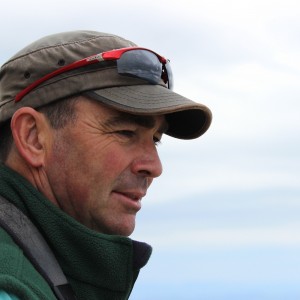
James brings some twenty five years of guiding experience to Naturalist Journeys. Originally from Sheffield in the United Kingdom, he discovered a love for guiding in Israel in 1995 where he helped establish the Kibbutz Lotan Center for Birdwatching in the Southern Arava Valley. Since then, he’s led hundreds of tours throughout the Northern Hemisphere for a number of UK-based tour companies. His trips to Israel and North America are especially close to his heart but he’s also led or co-led tours to Mexico (Veracruz), The Gambia, Kenya, Iceland, Scottish Highlands, Spanish Pyrenees, Central/Southern France, Greece (Lesvos), and India (Goa). An accomplished illustrator, James placed runner-up in the British Birds “Bird Illustrator of the Year” competition in 1992 and went on to have his work published in numerous birding magazines and journals. He also co-authored the two volume set A Guide to the Birding Hotspots of Israel (Published in 2000 by the Israel Ornithological Center and the S.P.N.I.). He returns to Israel every year to lead trips and remains an active member of the Israel Rarities and Distribution Committee. When not leading tours he can be found at home in Western Massachusetts with his wife Susannah and their young son Matan.
Other trips with James P. Smith
-
 Trinidad & Tobago: Incredible Birds & Wildlife CLOSED - See our other January departure!January 4 - 13, 2026
Trinidad & Tobago: Incredible Birds & Wildlife CLOSED - See our other January departure!January 4 - 13, 2026 -
 Belize: Three Great Lodges FULL - See our March departure!February 18 - 28, 2026
Belize: Three Great Lodges FULL - See our March departure!February 18 - 28, 2026 -
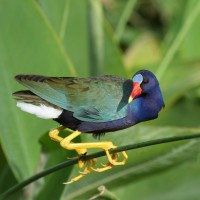 Texas Coast & Big ThicketApril 15 - 23, 2026
Texas Coast & Big ThicketApril 15 - 23, 2026 -
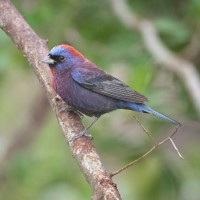 Texas Hill CountryApril 24 - 29, 2026
Texas Hill CountryApril 24 - 29, 2026 -
 Cape May: Spring MigrationMay 12 - 18, 2026
Cape May: Spring MigrationMay 12 - 18, 2026 -
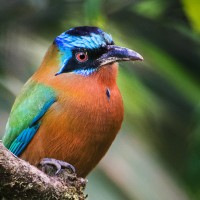 Trinidad & Tobago: Incredible Birds & WildlifeJune 15 - 24, 2026
Trinidad & Tobago: Incredible Birds & WildlifeJune 15 - 24, 2026 -
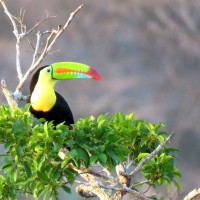 A Week at Belize's Black Rock Lodge A Short & Sweet Summer Birding BlitzJuly 19 - 25, 2026
A Week at Belize's Black Rock Lodge A Short & Sweet Summer Birding BlitzJuly 19 - 25, 2026 -
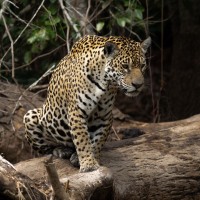 Brazil’s Pantanal: Jaguars! And More… FULL - See our June Departure!August 15 - 25, 2026, w/Amazônia extension
Brazil’s Pantanal: Jaguars! And More… FULL - See our June Departure!August 15 - 25, 2026, w/Amazônia extension -
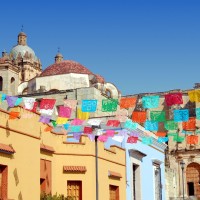 Grand Oaxaca: Valley, Mountains & Coast October 19 - 30, 2026
Grand Oaxaca: Valley, Mountains & Coast October 19 - 30, 2026
-
Essential Information +
Pace & Protocols +
Packing List +
Suggested Reading List +
Useful Links +
Photo credits: Banner: Hummingbirds by Linda Paine; Santa Marta Scenic, Naturalist Journeys Stock; Naturalist Journeys Group by Linda Paine; Sunset by Linda Paine; Birding Colombia, Naturalist Journeys Stock; Red Howler Monkey, Naturalist Journeys Stock; Gustavo Guiding by Peg Abbott; White-tailed Hillstar by Peg Abbott; Adventure Birding, Naturalist Journeys Stock; White-tipped Quetzal, courtesy Neblina Forest; White-tailed Hillstar by Peg Abbott; White-headed Marsh Tyrant, by Sandy Sorkin; Blue-naped Chlorophonia, Linda Paine; Russet-throated Puffbird, Peg Abbott; Adventure Birding, Peg Abbott; Santa Marta Warbler, Peg Abbott; View from El Dorado Lodge, courtesy of the Lodge; El Dorado Lodge, Linda Paine, Hummingbirds at Feeders, Linda Paine; El Dorado Lodge, Linda Paine; Plumbeous Kite, Linda Paine; Birding Colombia, Alan Epstein; Villa Maria, Linda Paine; Birding Colombia, Alan Epstein; Birding Colombia, Peg Abbott; White-headed Marsh Tyrant, Sandy Sorkin; Masked Trogon, Greg Smith; Groove-billed Toucanet, Peg Abbott; Santa Marta Brush Finch, Peg Abbott; Roseate Spoonbill, Betty Andres; Blossomcrown, Peg Abbott; Cinnamon Flycatcher, Peg Abbott; El Dorado Sign, Peg Abbott; El Dorado view, Peg Abbott; Slate-throated Redstart, Peg Abbott; Sparkling Violetear, Peg Abbott; Squirrel Cuckoo, Sandy Sorkin.





